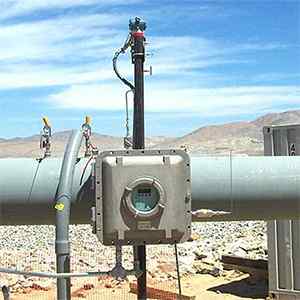Articles
Gas Analysers. Offering New Alternatives via Tunable Diode Laser based Analyzers

The traditional gas analyzer market has been consistently grappling with reliable measurement of low concentration gases. Various principles including IR, UV & VIS for Hetro atomic molecules, Lead Acetate tape for H2S, P2O5& AL2O3 for Moisture have been used. The most common challenges and problems faced by companies & users include
- High maintenance
- Frequent recalibration
- Air conditioned shelters / rooms
- Accuracy issues with interfering gases
- Wear & tear with moving parts
- Consumables including carrier gas
TDL / TDLAS Technology
TDL absorption spectroscopy (TDLAS) is a high-resolution technique that enables the measurement of specific gases with precision while avoiding interferences that are common with traditional analyzers.Tunable Diode Laser (TDL) technology is proved to be exceptionally reliable for measuring trace gas components like H2O, H2S, CO, NH3 & C2H2.
History of TDL Technology
During the late 1990 NASA selected &perfected TDL technology for its Mars Lander mission to find moisture or water on Mars. The spectroscopic technique developed had to withstand the rigors of space launch in terms of vibration, operate in extreme temperatures of space, be extremely accurate& reliable – there is no second chance, and high resolution.
In 1999 SpectraSensors Inc. was the first company to commercially use the TDL technology in the Process industry. The TDLAS technology available today includes Extractive, Cross pipe – tube &In-Situ. The Extractive type has proved to be most suitable &popular.

The TDLAS technology complements the present day analyzer technologies for measurement of low range concentration gases in critical, harsh environments especially in the Natural Gas Processing, Transportation, Petrochemicals, Refineries, LNG &Specialty Gas industries
Advantage of TDLAS Analysers
- Extremely Reliable measurements of low concentration. Intrinsically stable drift free lasers.
- Robustness of technology to work in extreme environments
- Accuracy
- Fast Response
- Low Maintenance
The advantages of TDLAS technology includes extremely stable measurements. Gases do not come in contact with the detectors, enabling very little maintenance and virtually eliminating requirement of recalibration.

How does it work?
As the light passes through the gas sample, energy is absorbed, reducing the amount of light arriving at the detector. The SS-Series analyzers use long lasting and resilient Tunable Diode Lasers that emit near-infrared light. The robustness of Diode Lasers is proven in many consumer and commercial applications such as CD players and fiber optic communications.The length of the laser beam affects the sensor’s sensitivity and hence some companies offer the dual-pass optical path in most applications (or a greater number of passes for some applications).

Fig.3 - A Typical Sample cell with source & detector
Primary Areas of Applications
- Natural Gas and Gas Processing including Pipelines – H2O, H2S, CO2
- LNG – H2O, CO2, H2S
- Refining & Petrochemicals – H2O, H2S, CO2, NH3, C2H2
- Specialty & Bulk gases
- Metrology & Climate Research
Natural Gas
All natural gas contains H2O (moisture)which is measured in natural gas pipelinesat production and gathering sites, custodytransfer points, compression stations,storage facilities and in the distributionmarkets.Moisture measurement is critical for gas companies to meet quality specifications and to protect pipelines from corrosion.Typical H2O Measurement Ranges 0-50, 0-100, 0-200, 0-500 ppmv

Similarly H2S& CO2is naturally occurring in oil and gas reservoirs. Produced gas containing high levels of H2S requires treatment to avoid corrosion problems.Typical Measurement Ranges 0-10, 0-20, 0-50, 0-100, 0-500 ppmv
LNG Plant
Using mole sieves for removal of moisture is a common drying techniquefor Natural Gas Processing plants. Several mole sieve vessels are operated in parallel and when saturated they are bypassed to be regenerated. H2O measurement indesiccant dryer outlets detect and avoid potential problems in downstream processes. Typical H2O Measurement Ranges 0-10 ppm
As with natural gas, H2S and CO2 are also of concern in LNG plants. Amine units are typically upstream of the liquefaction section. H2S and CO2 measurements are necessary. Typical Measurement CO2 Ranges are 0-100 ppm and Typical H2S Measurement Ranges are 0- 10 ppm.

Fig.4–Mole Sieve unit
LNG is produced and shipped at temperatures of approximately -160°C, so there is little likelihood of significant water concentrations in the LNG itself. However, there are a number of different approaches for the regasification of LNG, using air, gases or liquids heated by burning the gasified LNG and one of the most common is Open Rack Vaporizers using seawater as the heating medium.
Monitoring of vaporized LNG for water may be critical in some processes as an indicator of
leakage across the heat exchangers. In some cases, the gasified LNG may be mixed with other fuels that are wet.
Typical Measurement H20 Ranges 0-10 ppm
Petrochemicals
Ethylene is one of the most important feedstock for the petrochemical industry. Since itis used in the manufacturing of a wide range of compounds, Ethylene has very stringent purity specifications. One of the moreimportant steps in purifying the ethyleneis measuring the acetylene in the AcetyleneConverter Unit. The Acetylene Converter Unit consists of a series of reactors or a single vesselwith multiple beds of catalyst (Figure 5) whichreacts the acetylene with hydrogen to formethylene. It is critical that the acetylene be brought down to the proper levels as it exits the final reactor; otherwise, any acetylene present will follow the ethylene all the way to the final product stream. To avoid this producers will divert it to flare, a very costly decision. Typical C2H2 Measurement Ranges 0-3000 down to 0 - 5 ppm.

Moisture & Acetylene is measured in Pure Ethylene Gas and Typical Measurement Ranges vary from 0-5 to 0-10 ppm
Ethylene has very stringent purity specifications
especially for Polymer Grade Ethylene as Ammonia poisons polyethylene catalysts.
Sample points for Ammonia in Polymer Grade Ethylene are either in the Ethylene plant product or in a Polyethylene plant feed. In both cases the purity of the Ethylene must be verified.Typical Measurement Range 0-5 ppm
Fig.5–Acetylene Converter Unit

The Catalytic Reformer Unit of a modern refinery is an important process unit for converting lower octane naphtha streams into higher octane aromatic compounds. These chemical conversions are done in catalytic reactors that transform straight-chain C6-C8 compounds found in the naphtha into light
aromatics such as Benzene, Toluene and Xylenes (BTX). This high octane reformate can then be used in gasoline blending or sold to chemical plants. As shown in the figure, depentanized naphtha feed is mixed with recycled Hydrogen gas, preheated and passed through a series of reactors where the conversion to aromatics takes place. After the last reactor, a Hydrogen Separator strips out the Hydrogen and other light gases from the stream. After the removal of the Hydrogen, the stream enters a Stabilizer Tower (also called a
Debutanizer) that removes the Butanes and lighter gases with the Reformate
Fig.6 – C2H2, NH3 & H2O in Ehtylene Gas
leaving the Bottoms for gasoline blending or sent to a chemical plant.Refineries normally operate at about 5 – 50 ppm moisture in the Hydrogen Recycle stream. During catalyst regeneration moisture can be much higher.
Typical Measurement Ranges 0-50 ppm (control) and 50-500 ppm (trend)

Fig.7 – H2O& H2S removal CRU unit
Refinery
Refinery fuel gasis a collection of light gases generated in various refinery processes that have been processed to remove the valuable heavier components as well as most of the corrosive sulfur compounds such as H2S.These fuels are used extensively in process burners and heaters. Measurement of H2S in Fuel & Flare Gas. In such gases the background component gases vary with time. As such it becomes very difficult to measure with traditional technologies. GC have been traditionally used for such measurements but suffer from high cost of maintenance & operation.Typical Measurement Ranges 0-10 through 0-300 ppm
Specialty & Dry Bulk Gases
Moisture is one of the most important impurities in high purity gases such as Nitrogen, Helium, Hydrogen, Argon and Carbon Dioxide. These gases are frequently used for purge or blanket gas because moisture from the atmosphere air can damage equipment or a process. Hence purity of gas is most important.Typical Measurement Range 0-10 ppm
Partial Application List
Natural Gas

Gas Processing

LNG

Olefins (Petrochemicals)

Refinery

Specialty Gas / Syngas


(Hemal Desai is graduate in Instrumentation Engineering and has over 23 years of experience in process control & automation business. Currently he leads the Solutions Group at Endress+Hauser India Pvt ltd.)
Photos Courtesy – SpectraSensors Inc
Contact: hemal.desai@in.endress.com
Compiled by Endress+Hauser India Pvt ltd.





